For some time I’ve been posting cooking notes on Facebook (including a slightly earlier draft of this one). Henceforth, I’ll be posting them here, under the “Sassi Saucier” category.
TL;DR: Duck confit with jicama fries and a rhubarb jus; Szechuan peppercorn duck breast with rhubarb-jicama slaw. Skip to the recipes.
If there were an Epicurean Guild I were trying to get into, this might be my masterwork submission. I do not say that lightly. It’s spectacular. I’m not even going to “IMHO” that. (That Sassi, she is not humble.) From my researches during the 2014 Rhubarb Season, I present:
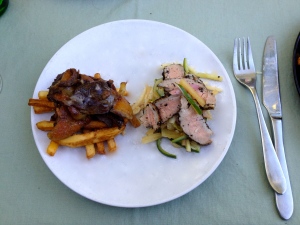
Duck, Rhubarb, Jicama: Two Ways.
Servings: 4-12.
- The confit-and-fries could serve 4 on its own if you made twice as many fries as I made for Two Ways, and had a salad.
- The slaw is enough for 4 duck breast fillets. I only made two fillets during the Two Ways prep. (So, if you were only making one Way, you should use 4 duck breast fillets for 4 entree servings.)
- The pairing could probably serve 8-12 as an appetizer or small plate.
Logistics Time: Seven weeks, if you’re me right now.
Necessary Time for the Two Ways Prep, if All Goes Well: At least 6 days.
Active Time: About 6-8 hours; less if you use a mandolin or food processor. (Writing that last phrase made me shudder a bit. I enjoy julienning with a knife. Knifework is one of the main reasons I like cooking. I won’t think less of you if you use a more efficient tool.) (Retronote, from January 2015: Will there be spiralized slaw next time? Yes. Yes, there will.)
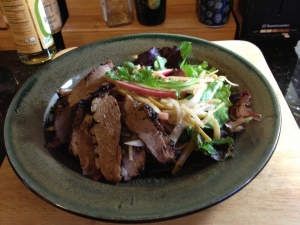
Last year’s Duck with Rhubarb-Jicama Slaw was more than dinner to me. It was an artwork, and a re-awakening. I’m grateful to it. My second take wasn’t quite right. I liked it very much at the time, and using gingered Lapsang souchong as a braising liquid went well, but it was the wrong cook for the cut, and the wrong time of year for a braise. As rhubarb season ended last year, I was considering replicating the braise with legs, in a “two ways” prep. When I started planning for it this spring, though, it didn’t feel like there was enough contrast on that plate. I needed something super-silky and something crunchy against the crisp cool sweet-and-sour of the chilled Take 1. And then I started thinking about duck confit, and then jicama fries, and the whole vision shifted.
I won’t be offended if you want to skip the narrative/contextual musings and go straight to the recipes. I’ll even give you links:
Szechuan Peppercorn Infused Oil (for finishing, used in both Ways)
~~~
Silk Road Duck Confit
Jicama Fries
Rhubarb Sauce
~~~
Duck Breast with Szechuan Peppercorns and Lapsang Souchong | Rhubarb-Jicama Slaw (this is one recipe, because of several shared elements)
I thought of calling this note “Sassi Saucier, You Stop Showing Off Right Now!”, but there were too many obstacles to a smooth performance. This is not a recipe, exactly. It’s not something I expect anyone to replicate. It is a somewhat cautionary but ultimately triumphant tale about the frustrations of artistry. Trying to serve the Tenth Muse at this level while (a) spending 10 out of 11 weekends away from home and (b) wanting to stay in good standing at a highly complex job with a long commute is not for the faint of heart.
Another caveat: This is a costly undertaking, especially the first time, assuming that you don’t already have Szechuan peppercorns and Lapsang souchong (pine-smoked black tea). It also assumes that you have access to ingredients like Szechuan peppercorns and Lapsang souchong. That’s part of the “Stop Showing Off Right Now!” aspect: It’s really not frugal at all. It’s on the verge of profligate. Heck, in global economic terms, this may as well be a recipe for saffron-marinated larks’ tongues dipped in gold. The amount of fat you need for confit is not cheap, and the duck legs I got were around $30 for four (you can probably find them for less, if you have time to look, or if you hunt, or live near a duck farm, or raise your own ducks). But it still comes out to less per person than, say, going out for good sushi. Also, you get to keep almost all of the cooking fat and re-use it—not just for confit, but for frying, hence what happens to some of the jicama below.
I was actively trying to make this dish for more than six weeks. The first “Yes, it’s time, I’m going to make this!” ingredient-purchase was on Saturday, May 31. I was foiled repeatedly: non-available ingredients, spoilage, a short-seasoned ingredient that had to be fresh (not frozen), and one ingredient of wildly variable quality (I have seen some pretty horrible jicama this year). But the even bigger factors were the Plans Gang Agley (e.g., on a Wednesday afternoon, I would plan to leave the office and execute three steps in the process, but then I would end up needing to stay at work until 9pm, so those three steps didn’t happen, so the three I had planned for Friday couldn’t happen, and then by Monday the rhubarb had turned slimy…).
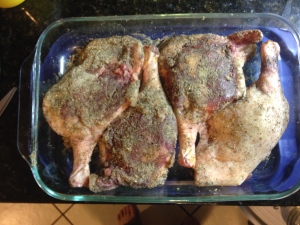
On June 6, 2014, I wrote “There are duck legs in my refrigerator, curing in a mixture of sea salt and Szechuan peppercorns and Lapsang Souchong tea.” I cooked the confit on June 7. It was a bit too salty on its own, but evocative. It made me think of Eleanor of Aquitaine, who went with an army on Crusade as far as Damascus. I imagine Eleanor there at the western terminus of the Silk Road’s overland route, where the spices took ship for Constantinople and on to Venice, tasting things no farm wife of her time could dream of. After that (for me, not Eleanor) came weeks of busy-ness and travel, many weeks in a row where I did not spend a whole day at home on the weekend, and during the week was only home to sleep and shower (and occasionally lie exhausted on the couch and watch The Sopranos on Amazon Prime). These were the weeks when I on more than one occasion had whey protein powder stirred into tap water for “dinner” at 9:30pm, because I didn’t have the wherewithal to even dirty a blender. (Right now, writing these notes, I just finished a “meal” of half a cup of walnuts and a glass of water with Key lime juice in it. I don’t cook like this all the time.)
Luckily, once made, my confit would be food-safe in the fridge for three months. I finally executed the entire vision over 4th of July Weekend. I brought two bags of ingredients and batterie items to my godfamily’s house—following a phone call, “OK, I can come for the whole weekend, but only if I can take over your kitchen for most of the day on Saturday. There’s duck confit in it for you.” Anna-Marie graciously consented.
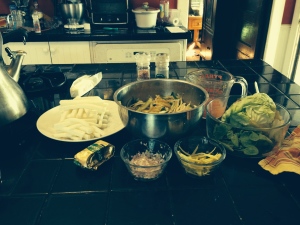
(On Saturday while I was cooking, she said “I keep wanting to brag-post that Sassi Saucier is experimenting in my kitchen, but then I worry that other people might come over and try to eat this food, and I might hurt them with my teeth.”)
She did not hurt anyone with her teeth. She did produce a vinho verde to go with this, which was perfect.
These recipes are not exactly what I made; they are what I would make next time, based on lessons learned in the first three takes. If you want to try to make this, I recommend that you make one Way at a time; Two Ways is just too fraught with possible mishap unless you have a huge amount of free time, a well-appointed kitchen, and possibly some helpers. The confit-and-fries Way can be done at any time of year (jicama is seasonless, and you could use frozen rhubarb for the sauce). Without the slaw, the confit would need some assertive sour-bitter notes to balance the palate—a sharply acidic peppery salad (arugula, grapefruit…) or some lemony roasted Brussels sprouts. (Actually, the more I think about it, the more I like the sprouts idea. The salad stops making sense when I consider the sauce that’s also on the plate.)
What I will do from now on, and suggest you try, if you are so inclined: Duck breast and slaw in the spring/early summer; duck confit and jicama fries in the autumn-into-winter.
The jicama fries were good enough that I am actively looking forward to making them again. Jicama is lower in carbohydrates than potatoes, but coating the fries with cornstarch adds those back—you’re not saving many carbohydrates or calories (if any), according to the recipe app I use. They might have a better glycemic index; I don’t know how to calculate that. But the flavor of the jicama fries was surprising—a bit nutty, a bit sweet, unexpected. They also feel lighter on the belly than french fries, to me. An excellent match with the duck confit.
Speaking of which: I had never made my own duck confit before, so I did a bit of recipe research and discovered that (a) you can make acceptable confit with butter, and (b) the listed storage times for confit vary widely by recipe, depending on how much salt is used in how long a cure. Since the storability of confit is part of its charm to me (atavistic approval from the Grandmothers), I went for a higher salt/longer cure version. This was lucky, given all the Gang Agley that was about to happen. Otherwise I might have lost a batch of duck confit to spoilage, which I’m pretty sure would have made me cry.
The dry rub I used was sea salt, Szechuan peppercorns, and tea, but the (beautiful, mysterious) numbing quality of the peppercorns didn’t come through the confit process, so I’m recommending a different spice cure and a Szechuan peppercorn-infused finishing oil.
I. Szechuan Peppercorn Infused Oil
Adapted from The Curried Cook which cites Susanna Foo Chinese Cuisine.
Batterie de Cuisine (French-cooking-talk for “stuff you’ll need that isn’t food”; I’ll say “batterie” for short below):
- A fan or good kitchen vent
- A heavy skillet (or a wok, I guess, but I don’t have a wok)–NOT non-stick
- Knife, cutting board
- 1-cup measure
- Tablespoon
- Stirring implement that you like
- Mortar and pestle or spice grinder
- Storage jar or bottle that holds at least 1 cup (if using a bottle, then also a funnel that fits the bottle)
- Strainer
Ingredients
- 2 T Szechuan peppercorns
- 1 cup grapeseed or other high-heat-tolerant, neutrally-flavored oil
- 3 cloves garlic, peeled & smashed with the flat of your knife
- 1/2-inch piece of ginger, cut into coins and smashed
Method
- Open your kitchen window, if you have one, and set up a fan pointing out. If you don’t have a kitchen window, turn on whatever ventilation you have as high as it will go, and disable nearby smoke detectors (by popping out their batteries or putting a shower cap over them).
- Heat the dry pan over medium heat until hot (a drop of water sizzles and vanishes).
- Pour in the peppercorns (there might be smoke). Reduce heat to low. Roast peppercorns for 10-15 minutes, shaking the pan frequently, until strongly fragrant. (There might be more smoke.)
- Turn the heat off.
- Grind peppercorns coarsely and return them to the pan.
- Heat back on medium; add oil, garlic, and ginger to the pan. Cook 3-5 minutes, stirring occasionally, until the garlic is browned. Remove the garlic so it doesn’t burn.
- Leave the oil on the stove off-heat to cool.
- Re-enable your smoke detectors.
- Once the oil is cool, strain it into a storage container. It keeps indefinitely in the fridge.
Prep needs to begin at least 4 days and up to 3 months before you plan to eat this. Active time is only about 20 minutes, though.
Batterie
- Roasting pan
- Paper towels
- Cover for the roasting pan, or foil
- Spice grinder (the electric kind, or a mortar & pestle)
- Slow cooker (at least 4 quarts; if you don’t have a slow cooker you can do this in the oven, but I don’t know times/temperatures, so you should go look at other duck confit recipes that use an oven.)
- Tongs
- Small sharp knife
- Heavy skillet (cast iron is great)
- Ladle
- Heatproof bowl (3-4 quart)
Ingredients
- 4 whole duck legs (I used Moulard, because that’s what I could find and it’s traditional for confit)
- 4 T sea salt (I used fine grey Celtic)
- 1 T Szechuan peppercorns
- 1 T black peppercorns
- 1 tsp cayenne pepper
- 1 T Lapsang Souchong tea leaves
- Duck fat and/or butter, sufficient to submerge the duck legs. The necessary amount will vary based on your cooking vessel. For my 4-quart slow cooker, I used 24 oz duck fat and 16oz of unsalted Kerrygold butter.
Method
Day 1
- Rinse the duck legs and dry them thoroughly.
- Grind the salt and spices (including tea) to a fine powder–I used an electric spice mill. (Originally, I roasted the peppercorns and salt together, but we’re skipping that step and I’m recommending you use finishing oil instead.)
- Rub into all surfaces of the duck legs. Put them in a tightly covered pan (I use a 9×12 Pyrex roaster with a lid) in the refrigerator for at least 12 hours and up to 3 days (I did 36 hours from rub to rinse).
Day 2 (that is, your second active day—it might be three days later…)
- 1 head garlic cloves, separated, flat ends trimmed
- Equal amount (by eye) of ginger, cut into pieces about the same size as large garlic cloves
- 1 tsp whole Szechuan peppercorns
- 1 tsp whole black peppercorns
- Rinse the rub off the duck and pat dry again.
- Nestle into slow-cooker crock, with unpeeled garlic cloves and pieces of ginger snuggled around legs. (A 4-quart slow cooker is just barely big enough.)
- Melt duck fat and/or butter in a saucepan over medium heat; pour over duck. Duck should be completely submerged. If you don’t have enough duck fat, don’t panic—just top up with more butter.
- Set the slow cooker on High for one hour. Reduce to Low and cook for another 3-4 hours, until the meat shreds easily when you poke it with a fork, and the drumstick-meat is all drawn back, exposing the bone.
- Take the legs out of the fat with tongs. Taste a shred. Optionally, have some entertaining thoughts about Eleanor of Aquitaine, the Silk Road, the forces that drive exchange between cultures, and the amount of travel that went on in the 12th century.
- Ladle the clear fat out of the slow cooker into a clean glass bowl.
- Separate out the garlic and ginger, and remove all the stock—you want an empty slow cooker and a bowl of clear, warm, liquid fat. (Ideally you would freeze the stock and melty-soft garlic and ginger, and puree it into the sauce later, but that assumes a level of Non-Agley-Plans that I cannot expect of anyone.)
- Wipe out the slow cooker crock with hot water, so there are no obvious particles clinging to the sides or bottom. Place the legs back in the crock or in another similar-sized container—you can trim off the bones, if you like. (I kept the legs in my slow cooker crock, but that was when I thought I’d be executing the rest of the dish within days. It was a pain to have my slow-cooker out of commission for weeks. I recommend using another covered container for storing your confit.)
- Pour the still-warm fat back over the legs very slowly—slow pour = lower risk of air pockets. (I don’t know if that’s true, but it felt correct to pour slowly.)
- Gently bump/tap the crock against the counter two or three times to remove possible air bubbles. Let cool on the counter for a while, and then put in the fridge for at least a couple of days—there’s flavor development that has to happen.
Day 3
This can be any time from two days after you cook the confit to up to however long you are brave enough to keep it. I imagine there’s a rule of thumb, about how long a cure = how long to store, but I haven’t found one. I would have been scared to eat my 36-hour-cured confit after three months.
- Four hours before dinner: Take the confit out of the fridge and let it come up to room temperature (this takes a couple of hours, which would be a great time to make a salad or roast some sprouts).
- Two hours before you want to eat: Lift the legs out of the fat, and scrape off as much fat as you can (back into the crock!) The legs will be a little bit grey and alarming-looking due to the tea, but don’t worry; they’ll brown up just fine. (I should have taken a picture, but my hands were covered in duck fat.)
- Pull the meat off the bones (keep the bones!)—leave the skin and meat attached to each other as much as possible. Cut into bite-sized pieces—most of the pieces should have both meat and skin. (I had planned to brown the legs whole, as is traditional, but that wasn’t working well—not enough skin-to-pan contact.)
- Put the meat in a large skillet in a single layer over low-to-medium heat to crisp up slowly and heat through, turning once or twice—about 20 minutes.
III. Rhubarb Sauce for Duck
(Untested! The Two Ways Day sauce did not behave as I wanted, because I crisped the confit in a nonstick pan and got no fond at all. So, here’s how I would try it next time.)
Time: About 2 hours
Active time: About 20 minutes? I think? I haven’t tried this. Also, it would depend on whether you have to peel your rhubarb or not.
Batterie
- Small saucepan
- Knife, cutting board
- Stick blender, regular blender, or food mill
- The skillet you’re using to crisp the confit, above—DO NOT CLEAN IT between crisping the confit and making the sauce!
- Whisk
Ingredients
- Bones from 4 legs of duck (from confit you made before; it’s not like you have to go find more bones just for stock…)
- One lobe of shallot, smaller than an egg, finely chopped (about 1/4 cup)
- 1 tsp fat from your confit crock
- 3 cups water
- 1 cup (yield from 2-3 stalks depending on size, duh) of fresh or frozen rhubarb. If fresh, cut into 1-inch pieces (possibly peel it first—try a piece and see how fibrous it is. If you end up with a wad of wooly fibers in your mouth, peel the rhubarb—catch the outer layer with a paring knife and strip it off the stalk, a bit like de-stringing celery). If frozen, it’s already cut and there’s not much you can do about the fiber.
- 2 tsp honey
- 1 T cold butter, cut into small pieces
Method
- A couple of hours before dinner: In a small saucepan, sauté a chopped shallot in 1 tsp of confit fat with a pinch of salt until soft and fragrant.
- Add the bones from your confit (above). Add about 3 cups of water and bring to a boil—but as soon as it comes to the boil, turn down to a slow simmer and keep an eye on it while you do other stuff; allow it to reduce to 1 cup.
- 45 minutes before dinner, add rhubarb and continue to simmer.
- 10 minutes before dinner, remove the bones and puree the sauce; then use the puree to deglaze the confit-crisping pan, above. (I guess if it seems really fibrous you should strain it. Again, much depends on the specific rhubarb.)
- Whisk in the honey, and then some small pieces of cold butter one at a time until the texture of the sauce pleases you. (I’d go with “coats a spoon”, but again, I haven’t tested this part. I almost don’t want to put the notes up until I do. But that might mean you wouldn’t get notes until September, which doesn’t seem fair.)
- Taste and adjust seasoning—remember, confit is salty, and you’ve got spicy finishing oil, so you just want to check that nothing’s really out of balance. The sourness of specific rhubarb might mean you need to add more honey. The sauce shouldn’t be sweet, though—it should be a balanced sour.
- Serve in a ramekin on the side, unless you can figure out a plating approach that doesn’t make the fries soggy.
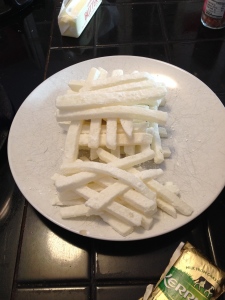
IV. Jicama Fries
Prep: 30 minutes? Not sure. Cook: 7-10 minutes per batch; you’ll probably need to do 3-4 batches depending on your skillet capacity. I guess you could do more than one pan at a time if you’re ambitious.
On Two Ways Day, I made half-a-medium-jicama worth of fries and half-a-medium-jicama worth of slaw. Everyone wanted more fries, and we had leftover slaw. I have adjusted the proportions here. It still might not be enough fries for some people…
Batterie
- Chef’s knife, paring knife, cutting board
- Plate or shallow bowl (for dredging)
- Another plate (for holding the dredged jicama)
- Large skillet
- Frying-strainer-implement—at a minimum a slotted spoon, but preferably a mesh skimmer or “spider” strainer
- Newspaper or paper towels or rack for draining
- Maybe a cookie sheet, if you’re doing 4 batches and you want to keep the early batches hot while the later ones cook. Oven at maybe 275, leave it ajar.
Ingredients
- 1 large jicama (I didn’t weigh it—it was about the size of a large slightly squashed grapefruit)
- Cornstarch—I think you’ll need about 3/4 cup, but it won’t all stick
- Enough confit fat to fill your skillet 2/3 inch deep (this was about 1/3 of the confit-fat I had)
- OPTIONAL: 1 very long thumb of ginger—the longest straightest piece you can find, like a central digit on a large hand.
Method
- Peel a large jicama
- Cut into 1/3-inch julienne.
- Blanch in rapidly boiling salted water for one minute.
- Scoop into a colander and shock with cold water. Drain very well. (Don’t skip the blanching. We did blind taste tests of blanched vs. unblanched and it was unanimous.)
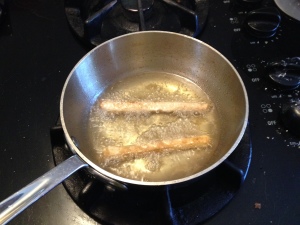
The top fry was not blanched. The bottom one was. Blanching = softer inside, crispier outside, more even browning, sweeter flavor. - Roll in cornstarch—have plenty on hand; I think it will take about 3/4 cup for a whole jicama, but it doesn’t all stick. (I thought about shaking it in a bag, but there’s an explosion hazard with that much airborne cornstarch…). You could season the cornstarch, if you want, but I did not—I wanted it to be very plain and stand as a crunchy sweet thing against the velvet-salty confit.
- Tap the coated fries against a plate to shake off the excess, and stack them in a log cabin stack so they dry a bit without touching each other too much. (See photo at the top of this section.)
- OPTIONAL but recommended: Peel the ginger with a spoon, slice into thin-as-you-can planks. Whack each plank with the flat of your knife to break up the fibers, and then stack the planks and julienne them. You want long tangles of ginger.
- Heat the confit-fat about 2/3 inch deep in a heavy skillet over careful, attentive, medium heat. I tested the heat with a single thread of ginger—I put it in cool, and then waited for the ginger to get sizzly before I started frying.
- If you’re doing ginger strings, fry them first—sprinkle them in so they don’t wad up, and move them around a bit while they fry to fragrant gold. (They turn very spicy and crunchy, and make the fat all ginger-y.)
- Fry jicama fries: I did two single-layer batches, about 10 minutes each, until they are a pleasing golden brown and the bubbles around them get very small. (The fat never reached smoke-point when I did this; if yours does, pull it off the heat and drop in a few sacrifice fries to bring the temperature down.) As noted, though, I didn’t make enough fries, so you might have to do more batches.
- Drain the fries on newspaper or paper towels or on a wire rack with newspaper under it.
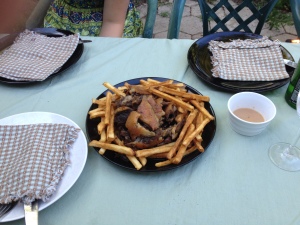
Plate: fries, confit, and rhubarb sauce (preferably with a bitter-acidic-noted salad or roasted veg, which you somehow magically made while you were waiting for the confit to come to room temperature.) Drizzle the confit with the Szechuan peppercorn finishing oil and top with ginger strings. (Ooh: In the fall when I do this I might put some port in the sauce to make it a deeper magenta…)
Duck Breast with Rhubarb-Jicama Slaw, 2014 Edition

Time: 4 days from start to serve (you could probably do it in less time if you are home more than I am.)
Active time: about 90 minutes.
If you read Take 1 last year you can pretty much skip to the end, unless you are actually making this, in which case these are better instructions.
Batterie:
- Mortar and pestle (or you could use a spice grinder/coffee grinder power tool)
- 2 ramekins or small bowls (I use Pyrex ramekins so often that I don’t think I remember how to cook without them.)
- Paper towels
- A platter or large plate or small roasting pan, of a size that two duck breast fillets fit on
- Measuring spoons
- Decent stove
- Skillet with a lid
- Chef knife that you like
- Cutting board
- Paring knife
- Vegetable peeler (optional; sometimes jicama are tricky with a paring knife)
- 2-cup Pyrex measuring cup
- Small saucepan
- A normal teaspoon (not a measuring one; just one you would use to stir tea)
- Salad bowl (3 quart maybe?)
- Colander
- Plate, of a size that the colander can sit on
- Whisk
- Bowl big enough to whisk in
Ingredients – Days 1 and 2
- 4 frozen duck breast filets (the brand I like, Bell & Evans, come two to a package)
- 2 tsp Szechuan peppercorns
- 2 tsp Lapsang souchong tea leaves
- 1/4 tsp smoked salt
- 2 tsp soy sauce
- 1 T honey
Ingredients – Day 3
- 3/4 lb of fresh rhubarb, scrubbed, ends trimmed—the rhubarb I ended up with this year was quite coarse/fibrous compared to last year, so I peeled it. (It was a pound to start with.)
- 1/3 cup of rice vinegar (naturally brewed, NOT “seasoned” which has sugar in it)
- 1/3 cup of cider vinegar
- 1/3 cup agave nectar
- 1/4 tsp cinnamon
- 1/4 tsp Szechuan peppercorns
- 1/2 tsp dried orange peel
- 1 cucumber
- 1/2 of a large jicama (or a whole small jicama, which might be better, see below)
- 4 lobes of shallot (that’s usually 2 fresh shallots, but I got the peeled kind which are already in individual lobes—I’ll julienne things all day with a song in my heart, but peeling shallots makes me grumble.)
- 3 T grapeseed oil (or other neutral/not-noticeably-flavorsome oil)
- 1 tsp toasted sesame oil
- 1/2 tsp hot mustard powder (Chinese or Coleman’s would both be fine; I ran out of Coleman’s and bought some Chinese mustard at Penzey’s. They are very similar.)
Method
DAY 1: Take duck filets out of the freezer (where I live they are typically sold frozen, 2 to a box, about 6 oz each) and put them in the fridge to thaw.
DAY 2: Eat something else for dinner, and prep the duck breasts with an overnight wet-and-dry rub: Put the Szechuan peppercorns and the tea leaves in a mortar and smash them up a little with the pestle (bonus points for humming “A Cup of Brown Joy“) until they are crushed/well-bruised; they don’t need to be powdery). Put one half in a ramekin and mix with 1/4 tsp smoked salt (this is your “dry rub”). Put the other half in a different ramekin and stir in 2 tsp grapeseed oil, 2 tsp soy sauce, 2tsp honey (this is your “wet rub”).
Take the duck out of its packaging. Rinse it. Dry it well.
Slash the skin of each filet in two directions so you end up with a diamond pattern. Try not to cut the actual meat, though I don’t expect devastation would follow if you did. I mean, you might lose some juices, but you don’t have to throw the filet away, or give up hope. Have courage and continue.
Spoon the wet rub in 4 blobs onto object that will hold your four filets; put the filets meaty-size down on the wet mixture. Make sure the meat is well-coated, but don’t coat the skin side–the wet rub (as I discovered last year) makes the skin rubbery. Rub the diamond-cut skin side with the dry rub. Cover with plastic wrap (or a lid, or some wax paper, whatever) and refrigerate until the next day.
Day 3!
This is all about the julienne, but there’s stove work as well. This took about an hour, from picking up the knife to taking the first bite. I changed the proportions from last year: More total rhubarb, higher proportion of raw rhubarb, less sweet.
In a small saucepan, combine the vinegar, agave, peppercorns, cinnamon, orange peel, and soy sauce; set over medium-low heat while you julienne things.
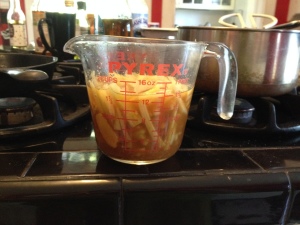
Start with the rhubarb, because it has to sit in the brine while you do other things. Julienne it. Notice that rhubarb feels amazing under the knife, like smooth-grained wood, as though julienned is all it ever wanted to be and it can’t believe we’ve all been cutting across the grain instead of along it this entire time. Put 1/2 of the rhubarb in a 2-cup Pyrex measuring cup (it’ll be about two cups, not packed). Reserve the remaining half (which you aren’t going to pickle).
Jack up the heat under the brine so it boils. Let it boil for maybe 30 seconds and then pour it over the rhubarb in the Pyrex. Set that aside (on the counter, not in the fridge).
Peel and slice the jicama into planks. Taste a piece. If it’s starchy, blanch it. (Sometimes jicama is juicy and sweet—if it’s like that, go with it and skip the blanching part). Rinse out the saucepan you used for brine and fill it with fresh water; put that over high heat and keep an eye on it. Go ahead and and finish julienning the jicama.
Peel the cucumber, split it lengthwise, and scoop out the seeds with a spoon. Split it lengthwise again so you have quarters; do your best to julienne them. (There’s no shame here. They are slippery and treacherous.)
The water might be boiling now. If it is, put the julienned jicama in it. Count to thirty. Drain the jicama into a colander and rinse it very well with cold water. Set the colander on a plate and put it in the fridge.
Cut the shallots very thinly lengthwise. You can’t really julienne them because they are too curvy.

Put the cucumber, shallots, and raw rhubarb into a bowl together.
Unwrap the duck breasts and set them on paper towels, meaty-side down. (You are drying off the wet rub so the meat will take a sear, and not just steam and get rubbery.)
Put a cold skillet on the stove. Put the duck in the cold pan, skin-side down. (This is a different cook from last year, and it’s much better.) Set heat to medium-low. Cook until there’s a good amount of rendered fat and the skin is deeply golden (under the black of the dry rub)—7-8 minutes for medium, which is how I want it—”rosy”, not rare. (If you prefer duck more rare, that’s cool with me; just reduce the cooking time.)
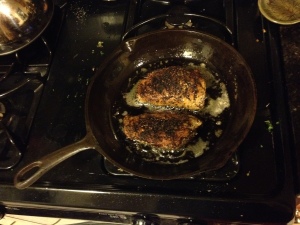
Scoop the rhubarb out of the brine and add it to the slaw (don’t do anything with the brine yet; you still need it). Get the jicama out of the fridge and add it to the slaw. Toss well, and put it back in the fridge.
Turn the duck breast. Set a timer for 6 more minutes (for medium-well) and cover the skillet, leaving the cover askew.
Pour a quarter-cup of the brine into the whisking bowl. Add the grapeseed oil, sesame oil, and mustard. Whisk well. You can discard the rest of the brine, or use it as a cocktail ingredient with seltzer and gin, or whatever floats your boat. Put dressing in the fridge.
Remove the duck from the pan to rest for another 5-10 minutes. Put it in the fridge, covered, to chill at least 2 hours, up to 48 hours.
To serve, when everything is cold: Pour dressing over slaw; toss gently but well. Slice duck breast thinly on the bias. Put some greens on the plate with the slaw on top; arrange duck slices on top to your liking. Drizzle with Szechuan peppercorn finishing oil.
Dream of next year’s rhubarb. Wake up, and find it is already peach season. And when autumn comes, there will be duck confit with jicama fries, and maybe a Lapsang souchong cassoulet…